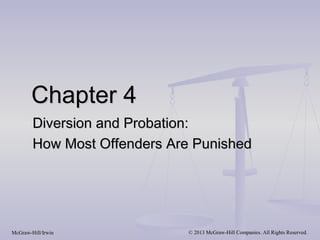
Ppt chapter 4
- 1. Chapter 4 Diversion and Probation: How Most Offenders Are Punished McGraw-Hill/Irwin © 2013 McGraw-Hill Companies. All Rights Reserved.
- 2. Diversion “The halting or suspension, before conviction, of formal criminal proceedings against a person, conditioned on some form of counter performance by the defendant.” Counter performance: The defendant’s participation, in exchange for diversion, in a treatment, counseling, or educational program aimed at changing his or her behavior. Examples: Drug Courts Mental Health Courts Domestic Violence Courts 4-2
- 3. Three Objectives of Diversion 1. Prevent future criminal activity by diverting certain defendants from criminal justice processing into community supervision and service. 2. Save prosecution and judicial resources for serious crimes by offering, for less serious crimes, alternatives to the usual prosecution process. 3. Provide, where appropriate, a vehicle for restitution to communities and victims of crime. 4-3
- 4. Rationales For Diversion The experience and stigma of formal arrest, trial, and conviction can actually encourage more criminal behavior. Diversion is less expensive than formal processing through the system. Public perceptions of inappropriateness of formal processing for certain (“victimless” crimes). Diversion gives typical clients a better chance at life. 4-4
- 5. Types of Diversion Unconditional: Terminates criminal proceedings at any point before adjudication with no threat of later prosecution. Offers treatment, counseling, and other services, the use of which is voluntary. Conditional: Dismisses charges if the defendant satisfactorily completes treatment, counseling, or other programs ordered by the justice system. 4-5
- 6. Probation The conditional release of a convicted offender into the community, under the supervision of a probation officer It is conditional because it can be revoked if certain conditions are not met. Types of conditions Monetary penalties, drug testing, employment requirements, and mandatory treatment. 4-6
- 7. Reasons for Probation Keeps offenders in their communities and facilitates reintegration Avoids the institutionalization and stigma of imprisonment Reduces the expense of supervision Fair treatment for offenders whose crimes do not merit incarceration 4-7
- 8. Goals Of Probation Protect the community Carry out court-imposed sanctions Identify probationers’ supervision and service needs Support crime victims Coordinate and promote use of community resources 4-8
- 9. History Of Probation Judge Peter Oxenbridge Thatcher laid the foundation for probation in Boston in 1830. Judge Thatcher made the first recorded use of release on recognizance in the U.S. In 1878, the Massachusetts legislature passed the first statute authorizing probation. On March 4, 1925 President Calvin Coolidge signed the National Probation Act. 4-9
- 10. Characteristics of Adults on Probation, January 1, 2008 On January 1, 2010, the number of adults on probation declined 0.9%, from 4,244,046 to 4,203,967, the first decline in the probation population since the Bureau of Justice Statistics began its annual probation survey in 1980. 4-10
- 11. Does Probation Work? APPA Data Amount of restitution collected Number of offenders employed Amounts of fines and fees collected Hours of community service performed Number of treatment sessions attended Percentage of financial obligations collected Rate of enrollment in school Number of days of employment Number of days drug free 4-11
- 12. Research on Probation 1. Researchers found that over three-fourths of offenders on probation for a misdemeanor successfully complete their probation, but almost two-thirds of felony probationers are rearrested. 2. The percentage of all offenders successfully completing their probation terms is falling even though a recent study found that male property offenders on felony probation had a success rate of 67.7%. 3. Recidivism rates vary greatly from place to place, depending on the seriousness of the offense, population characteristics, average length of probation, and the amount and quality of intervention, surveillance, and enforcement. 4-12
- 13. Duties Of Probation Officers Case investigation Prepare the presentence report (PSR) Client-specific plans Supervision Intervention – providing offenders access to a wide variety of services Surveillance – monitoring the activities of probationers Enforcement – making probationers accountable for their behavior and making sure they understand the consequences of violating the conditions of probation 4-13
- 14. Presentence Reports (PSR) Provides a social and personal history as well as an evaluation of a defendant as an aid to the court in determining a sentence Two main purposes: Assists the court in reaching a fair sentence Outlines a treatment plan for the offender 4-14
- 15. Presentence Reports (PSR) Judges follow the recommendation over 80% of the time when probation is recommended and over 60% of the time when prison is recommended 90 percent of judges claimed to read the entire report from the beginning, but only 55 percent of all respondents (judges, prosecutors, public defenders, and probation/parole officers) indicated that they start at the beginning and read the entire report section by section. 4-15
- 16. Presentence Reports (PSR) The specific content areas of the PSR vary from jurisdiction to jurisdiction, but common areas include (1) information regarding the current offense; (2) the offender’s past adult and juvenile criminal record; (3) family history and background; and (4) personal data about education, health, employment, and substance abuse history. 4-16
- 17. Probation Revocation Revocation – the formal termination of an offender’s conditional freedom Revocation hearing - A due process hearing that must be held to determine whether the conditions of probation have been violated before probation can be revoked and the offender removed from the community 4-17
- 18. Revocation Triggers Technical violation – A failure to comply with the conditions of probation. Absconding, positive urinalysis, failure to participate in treatment, and failure to report to the probation officer are among the most common violations. New offense violation – The arrest and prosecution for the commission of a new crime. 4-18
- 19. Gagnon v. Scarpelli (1973) and Morrissey v. Brewer (1972) A probationer is entitled to: Written notice of the charge Disclosure of the evidence The opportunity to be heard and to present evidence and witnesses Confront and cross-examine witnesses Judgment by a detached and neutral hearing body A written statement of the reasons for revoking probation Counsel 4-19